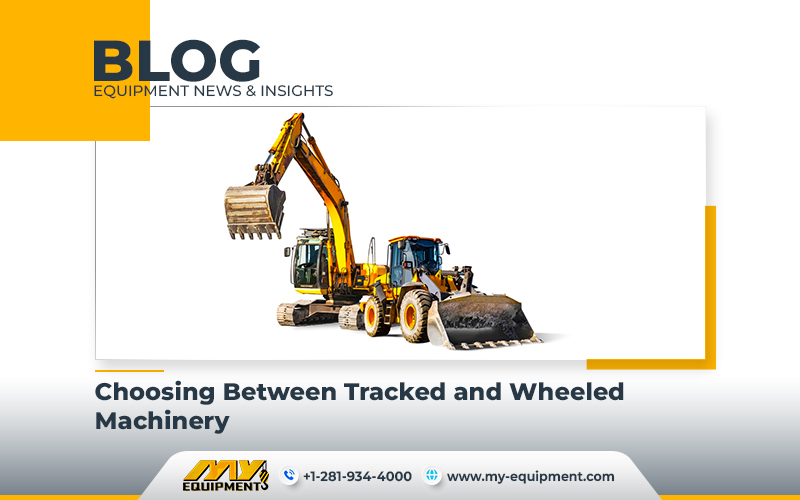When it comes to renting or purchasing heavy machinery, such as excavators or loaders, one very important decision to make is whether to opt for tracked or wheeled equipment. Each type of machinery has distinct advantages and uses, and understanding their differences can help you select the right machine for your job requirements. Today, we will explore the distinctions between tracked and wheeled equipment, highlight the advantages of each, and provide guidance on how to choose the most suitable machinery for your specific needs.
Tracked Equipment Advantages
Tracked machinery offers several benefits that make them an attractive option for various applications. Consider the following advantages when deciding on the right equipment:
Stability and Smooth Rides
Tracked machinery, with their larger bases and footprints, tend to provide smoother rides compared to wheeled equipment. They offer better stability, reducing the likelihood of instability caused by dips, bumps, or uneven terrain.
Consistent Traction
Tracked equipment excels in maintaining traction consistency. Unlike wheeled equipment, which may lose traction and become unsafe, tracked machines distribute power to the ground consistently, ensuring reliable performance even in challenging conditions.
Durability and Reduced Downtime
Tracked equipment is known for its durability and resilience. Unlike tires, which can deflate or puncture, tracked machines are less prone to such issues. Additionally, they are less affected by sideways jolts. This durability reduces downtime, leading to increased productivity for your business.
Improved Seasonal Performance
Tracked equipment is highly effective in navigating soft and wet terrains, allowing them to operate earlier in spring and later in the fall. Compared to wheeled equipment, which can easily get stuck in muddy terrain, tracked machinery with rubber tracks provides greater maneuverability, speeding up project completion and increasing profitability.
Flexibility in Various Environments
Tracked machines offer superior versatility as they can operate effectively in a wide range of working environments. They excel in open spaces as well as wetlands, providing greater flexibility compared to wheeled machinery.
Advantages of Wheeled Equipment
While tracked equipment boasts several advantages, wheeled machinery also has its place in specific applications. Consider the following advantages when considering wheeled equipment:
Adaptability and Attachment Options
Wheeled machinery is highly adaptable and can be equipped with various attachments. This versatility allows them to perform tasks such as trenching, material spreading, and snow plowing. Wheeled equipment can even be fitted with slip-over tracks, providing the option to convert them into tracked machines based on your application’s demands.
Cost-Effectiveness
Purchasing or renting wheeled equipment is often more cost-effective compared to tracked machinery due to the lower initial cost. Wheeled machines require less support and maintenance, as they primarily rely on tires, brakes, and hubs to absorb ground impact. This results in lower operating expenses and longer equipment lifespan.
Ease of Transportation
Wheeled equipment is easier to transport compared to tracked machinery. While wheeled machines can be driven from one job site to another along roads, tracked equipment requires trailers and additional vehicles for transportation. The accessibility of wheeled equipment reduces the time and costs associated with organizing transportation.
Factors to Consider for Equipment Selection
To choose the right machinery for your job requirements, consider the following factors.
Cost vs. Lifetime Value
The initial cost of equipment should not be the sole factor in your decision-making. While wheeled machinery may be more economical upfront, they carry a higher risk of downtime. On the other hand, replacing tracks can be expensive for tracked machinery. Assess the lifetime value of each option and consider factors like maintenance costs and durability.
Mobility and Surface Grip
Evaluate how each machine performs on different surfaces and their maneuverability. Wheeled equipment excels on asphalt and icy conditions, while tracked machinery is better suited for soft or muddy terrain. Consider the specific conditions of your work environment and choose accordingly.
Durability
Take into account the expected lifespan of the equipment. Wheeled machinery generally lasts longer when operating on concrete or asphalt surfaces due to the design of their tires. However, if you frequently encounter hazardous terrains, tracks may be a more durable option. Consider the longevity of each machine based on your specific job requirements.
Job Requirements
The nature of your job plays a significant role in equipment selection. Wheeled machinery is often preferred for tasks like backfilling foundations or creating ditches. On the other hand, tracked equipment outperforms wheels on grass and other types of landscapes, making them ideal for spring landscaping, lot clearing, or trenching. Analyze your job requirements and choose the machinery that aligns with your specific needs.
Choosing between tracked and wheeled heavy equipment requires careful consideration of their respective advantages and your job requirements. Tracked equipment offers stability, traction, and component safety, with benefits like smooth rides, consistent traction, durability, and improved performance on challenging terrains. Wheeled equipment, while generally more cost-effective and adaptable, provides advantages such as attachment options, ease of transportation, and durability on specific surfaces, so it can be a tough decision. Assessing factors like cost, mobility, durability, and job requirements will guide you in selecting the right machinery that maximizes efficiency and productivity for your projects.


 1400 Broadfield Blvd, Houston, TX 77084,
USA.
1400 Broadfield Blvd, Houston, TX 77084,
USA. omer@my-equipment.com
omer@my-equipment.com